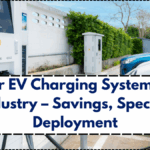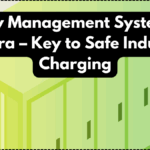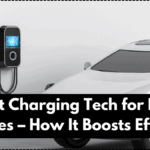As India continues to electrify its transportation infrastructure, industrial units face a new challenge: managing the energy demands of EV (electric vehicle) fleets without straining existing systems. The answer lies in advanced EV load optimization—intelligent strategies and technologies that help industrial operations align EV charging with energy availability, cost-efficiency, and sustainability goals.

What is EV Load Optimization?
EV load optimization refers to the strategic management of electric vehicle charging schedules, loads, and energy distribution. In industrial settings, this means aligning EV fleet charging with off-peak hours, integrating renewable sources, and avoiding excessive demand charges. It’s a smart energy approach that reduces operational costs while enhancing grid stability.
Unlike conventional charging, load-optimized systems are powered by AI-driven software that dynamically adjusts charging patterns based on multiple variables—electricity tariff rates, battery state of charge, real-time power consumption across the facility, and renewable energy input. The result? Efficient, non-disruptive charging that fits into existing industrial operations.
Why Industrial Units Must Embrace Smart Energy Systems
Industrial facilities are high-power consumers. Introducing a fleet of EVs without load planning can easily lead to peak demand spikes, inflated energy bills, and even grid instability. EV load optimization prevents this by spreading the energy draw over a wider time window, reducing peak loads and leveraging off-peak rates.
Moreover, EV load optimization supports broader smart energy initiatives, such as:
- Integration of solar and wind energy to power EVs directly
- Demand response participation (responding to utility signals)
- Reduced carbon footprint through cleaner energy utilization
- Scalable infrastructure that adapts to growing EV numbers
With government policies pushing for electrification and cleaner industrial operations, adopting smart EV charging is not optional—it’s a competitive necessity.
Technologies Powering EV Load Optimization in 2025
Recent advancements have introduced several cutting-edge solutions for industrial EV load management:
| Technology | Description | Benefit |
|---|---|---|
| Smart Charging Stations | AI-enabled chargers that monitor grid load | Real-time load balancing |
| Energy Management Systems (EMS) | Centralized platforms for facility-wide control | Optimize across all power loads |
| Vehicle-to-Grid (V2G) | EVs feed energy back to the grid | Dual-use energy strategy |
| Predictive Load Scheduling | Uses ML to forecast energy needs | Minimizes waste and overuse |
| Renewable Integration | Solar/wind linked to EV chargers | Clean, cost-effective energy |
These systems don’t just optimize charging—they transform the role of EVs into active participants in a smart energy ecosystem.
Real-World Use Cases from Indian Industry
Several industrial clusters across India are already implementing EV load optimization strategies. In Pune, an auto manufacturing plant uses solar panels linked with predictive load software to ensure that their internal EV logistics fleet charges during peak solar hours. In Gujarat, a textile unit has integrated V2G capabilities, reducing their net energy cost by 18% monthly.
Such examples underline a broader trend: EVs are not just a mode of transport—they are emerging as energy assets. By transforming charging infrastructure into responsive, intelligent systems, industrial players are not just keeping up—they’re getting ahead.
Conclusion
The transition to EVs in India’s industrial landscape is gaining pace, but without EV load optimization, it risks becoming inefficient and expensive. With the right smart energy tools—AI, EMS platforms, renewable integration, and predictive analytics—industrial units can ensure that electrification enhances both sustainability and profitability. As more businesses join this shift in 2025, those who optimize early will lead the way in cost-efficiency and energy resilience.
FAQs
What is the biggest challenge in EV load optimization for industrial units?
The biggest challenge is balancing the EV charging demand with existing energy consumption patterns without overloading the facility or incurring high electricity costs.
How does smart energy contribute to EV load optimization?
Smart energy solutions, like EMS and predictive scheduling, enable real-time adjustments and integrate renewables, which enhances the efficiency of EV charging in industrial settings.
Is EV load optimization expensive to implement?
While initial setup costs can vary, the long-term savings in energy costs and operational efficiency typically outweigh the investment.
Can small industrial units benefit from EV load optimization?
Yes. Scalable solutions exist, and even small facilities can benefit from smart charging and peak-load management.
What role will EV load optimization play in India’s energy future?
It will be central to managing increasing EV adoption, improving grid reliability, and advancing toward a low-carbon industrial economy.
click here to learn more



